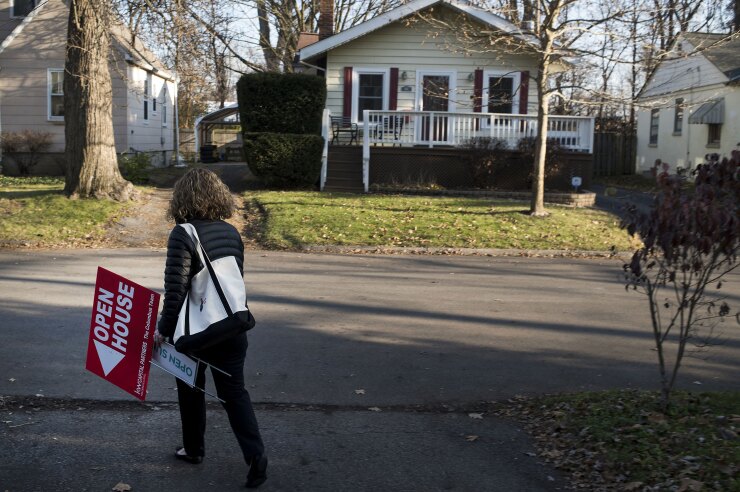When real estate investors get this confident, money manager James Stack gets nervous.
U.S. home prices are surging to new records. Homebuilder stocks last year outperformed all other groups. And bears? They're now an endangered species.
Stack, 66, who manages $1.3 billion for people with a high net worth, predicted the housing crash in 2005, just before prices reached their peak. Now, from his perch in Whitefish, Mont., he says his "Housing Bubble Bellwether Barometer" of homebuilder and mortgage company stocks, which jumped 80% in the past year, once again is flashing red.
"It is 2005 all over again in terms of the valuation extreme, the psychological excess and the denial," said Stack, whose fireproof files of newspaper articles on bear markets date back to 1929. "People don't believe housing is in a bubble and don't want to hear talk about prices being a little bit bubblish."
As the housing market approaches its key spring selling season, Stack is practically alone in his wariness. While price gains may slow, most analysts see no end in sight for the six-year-old recovery.
There are plenty of reasons to be optimistic. The housing needs of two massive generations — millennials aging into homeownership and baby boomers getting ready for retirement — are expected to fuel demand for years to come if employment remains strong. Sales in master-planned communities, many of which target buyers who are at least 55, reached a record last year, according to John Burns Real Estate Consulting. Last month, a gauge of confidence from the National Association of Home Builders/Wells Fargo rose to the highest level in 18 years, and starts of single-family homes in November were the strongest in a decade.

"As soon as homes are finished, they're flying off the shelf," said Matthew Pointon, Capital Economics Ltd.'s U.S. property economist.
Homebuilders, which have focused on pricier homes since the market bottomed in 2012, are now getting ready for a wave of first-time buyers left with little to choose from on the existing-home market. Investors are rushing to builders of starter homes, because lower-priced homes in the U.S. are in the shortest supply. Shares of LGI Homes Inc., which targets renters with ads that trumpet monthly payments instead of prices, rose 161 percent last year. D.R. Horton Inc., the biggest builder, powered by its fast-selling Express entry-level brand, gained 87%.
Overall, the S&P 500's index of homebuilders increased 75% last year, about four times as much as the stock market as a whole. A subset that includes just the three largest builders was the best performer of the 158 S&P groups.
"Over the past year, we've really seen a pickup in the first-time buyer, and that's what's driving a lot of the stocks," said Samantha McLemore, who co-manages Bill Miller's Miller Opportunity Trust, which has stakes in PulteGroup Inc. and Lennar Corp. "In the long term, we continue to see strong earnings growth for years to come."
Stack has a different perspective. While the market might gradually correct itself, history shows that it's more likely to "come down hard" with the next recession, he said. He described the pattern as a steep run-up in housing prices spurred by low interest rates. The last downturn came about when economic growth slowed after a series of rate increases, exposing the "rot in the woodwork" and prompting loan defaults, Stack said.
He noted that the Fed has projected three rate increases for this year, and said that "raises the risk that today's highly inflated housing market will again end badly." He's watching homebuilder stocks closely because they're a leading indicator, peaking in 2005, the year he called the crash — and the year before home prices themselves hit a top.
Stack has been studying median home prices, too, which typically track long-term inflation as measured by the Consumer Price Index. Last summer, they were as high as 32% above the measure; in 2006, just before the housing bust, values were about 35% higher, according to data from the National Association of Realtors. Half of the 50 largest metropolitan areas were overvalued relative to incomes in November, compared with 36% two years earlier, according to an analysis by data provider CoreLogic.
"If we see mortgage rates at more historical levels, house prices can't stay where they are," Stack said.
A rate rise from 4% to 5% for a 30-year loan would drive up monthly mortgage costs by 12%. For buyers, that's on top of the annual median price gain — 7% for existing homes in November, according to CoreLogic. By comparison, disposable income, or earnings adjusted for taxes and inflation, increased just 1.9%, according to data from the Bureau of Economic Analysis.
Bill McBride, who runs the Calculated Risk blog and also called the crash, doesn't think home prices are inflated this time around. Unlike in 2005, lenders are acting responsibly and the Wild West of real estate speculation hasn't returned, he said. There is less to speculate on, too. Compared with the overbuilding that preceded the bust, today's pace of construction isn't fast enough, he said.
"Lending standards are still pretty good," McBride said, and he doesn't expect mortgage rates to "take off" in the short term.
One wild card is the U.S. tax overhaul, which could cut both ways for homebuilders. They got a lower corporate rate, and many of their consumers will benefit from the doubling of the standard deduction. But it also caps the mortgage deduction at $750,000 instead of $1 million and limits deductions of property taxes, which might hurt expensive markets such as New York, New Jersey and California.
As a result of the tax plan and an expected gradual rise in mortgage rates, existing-home sales will be flat this year and prices will rise only 1% or 2%, said Lawrence Yun, the chief economist for the National Association of Realtors, which opposed the tax bill.
"The housing market has been doing relatively well during the recovery," Yun said. "But 2018 will be a year where we begin to see some change."
Homebuilders have a lot going for them, said Carl Reichardt, an analyst for BTIG LLC. Still, he has a hold rating on most of them, a sell on KB Home and a buy only on Lennar and D.R. Horton. That's because many of those positives are already baked into the share prices, he said, and home construction can grow only so much, given the tight supply of skilled laborers and finished lots.
"It's almost better for the stocks if the general consensus is for moderate growth rather than supercharged growth," Reichardt said. "It's the sense that a slow and steady recovery creates more predictability."
New-home sales will probably increase 8% to 12% this year after rising about 11% in 2017, said analyst Alex Barron with the Housing Research Center in El Paso, Texas. At 675,000 to 700,000 sales, that's still almost 50% below peak levels in 2005.
"Ever since Trump took over, the mood has been incrementally positive," Barron said. "Now that tax reform went through, people will have more money in their pockets."
Bill Smead, whose Smead Capital Management has 11% of its $2.4 billion portfolio in NVR Inc. and Lennar, said stocks in general could fall in the short run and that will provide an opening for investors to buy homebuilder shares.
"Nobody wants to take their gains now," Smead said. "There are no sellers."



